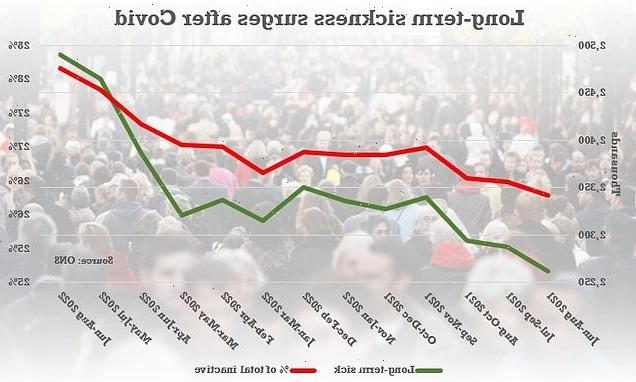
Sick Britain: Levels of long-term illness in labour force hits RECORD high as employment falls – while wages surge by unprecedented 6% but are STILL below rampant inflation
- Unemployment rate hit 3.4% in quarter to August, lowest since February 1974
- But employment also fell as a result of people being reclassified as ‘inactive’
- Economic inactivity up 0.6 percentage points to 21.7%, driven by 50-64s
Levels of long-term sickness have hit a record high in the wake of the Covid pandemic – as wages continue to be hammered by rampant inflation.
Official figures show the UK’s unemployment rate dropped to 3.4 per cent in the quarter to August, its lowest since February 1974.
But employment also fell, with the headline shift a result of people being reclassified as ‘inactive’.
Economic inactivity increased by 0.6 percentage points to 21.7 per cent, driven by people aged between 50 and 64.
The employment rate decreased by 0.3 percentage points to 75.5 per cent for the quarter.
Meanwhile, there was more evidence of the cost-of-living crunch. Total wages surged by 6 per cent and regular wages by 5.4 per cent.
However, that was far outpaced by inflation running close to double-digits. Accounting for CPI pay fell 3.4 per cent and 4 per cent respectively.
Pawel Adrjan, director of EMEA economic research at job site Indeed, said: ‘The labour market simply cannot get back on its feet after the pandemic.
‘The employment rate is down for a second consecutive month and still has not recovered to its pre-pandemic level, while the number of economically inactive working-age people has risen to its highest since 2015.
‘The continued rise in inactivity makes the UK an international outlier with long-term illness a major contributing factor pointing to a growing in-tray for the new health secretary. The labour force participation crisis keeps pulling us away from full pandemic recovery.’
Official figures show the UK’s unemployment rate dropped to 3.4 per cent in the quarter to August, its lowest since February 1974. But employment also fell, with the headline shift a result of people being reclassified as ‘inactive’.
Total wages surged by 6 per cent and regular wages by 5.4 per cent. However, that was far outpaced by inflation running close to double-digits. Accounting for CPI pay fell 3.4 per cent and 4 per cent respectively.
Pawel Adrjan, director of EMEA economic research at job site Indeed, said: ‘The labour market simply cannot get back on its feet after the pandemic.
The employment rate decreased by 0.3 percentage points to 75.5 per cent for the quarter.
Meanwhile, the number of UK workers on payrolls rose by 69,000 between August and September to 29.7 million, the ONS said.
ONS head of labour market and household statistics David Freeman said: ‘The unemployment rate continues to fall and is now at its lowest for almost 50 years.
‘However, the number of people neither working nor looking for work continues to rise, with those who say this is because they’re long-term sick reaching a record level.
‘While the number of job vacancies remains high after its long period of rapid growth, it has now dropped back a little, with a number of employers telling us they’ve reduced recruitment due to a variety of economic pressures.
‘However, because unemployment is also down, there continues to be more vacancies than unemployed people.’
In July to September 2022, the estimated number of vacancies fell by 46,000 on the quarter to 1,246,000, the ONS said, amid a slowdown in company investment.
The new data also showed another slight improvement in pay but it continues to lag far behind inflation.
Average pay, excluding bonuses, grew by 5.4% over the three months from June to August.
However, it comes after Consumer Price Index (CPI) inflation struck 9.9% in August, highlighting a still significant gap between Britons’ pay packets and the cost of goods and services.
In response, Chancellor Kwasi Kwarteng said: ‘Countries around the world are facing economic challenges but today’s statistics remind us that the fundamentals of the UK economy remain resilient, with unemployment at its lowest point for almost 50 years.
‘Our ambitious growth plan will drive sustainable long-term growth, meaning higher wages and better living standards for everyone, and we are cutting taxes so people can keep more of what they earn.’
Kitty Ussher, chief economist at the Institute of Directors, said: ‘The labour market remains extraordinarily tight with, for the first time ever, more vacancies in the economy than the number of people looking for work, and no let-up in hiring in September.
‘Although the level of vacancies now looks like it has peaked, it remains significantly higher than before the pandemic, at 1.2 million.
‘Combined with such a low rate of unemployment and pay rises edging upwards, we see no reason why the Bank of England would pause its upward march of interest rate rises when it meets in early November.’
Source: Read Full Article




